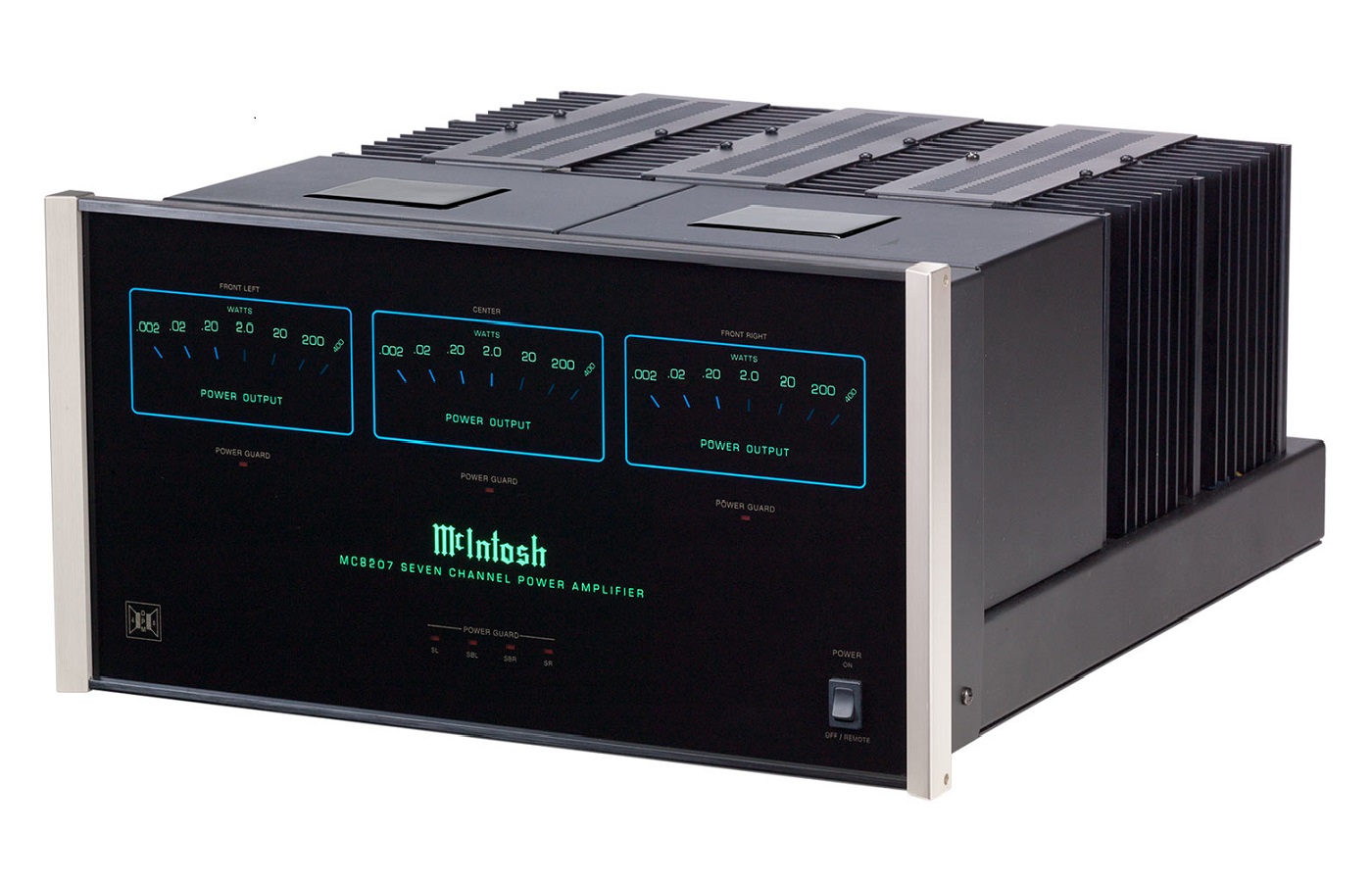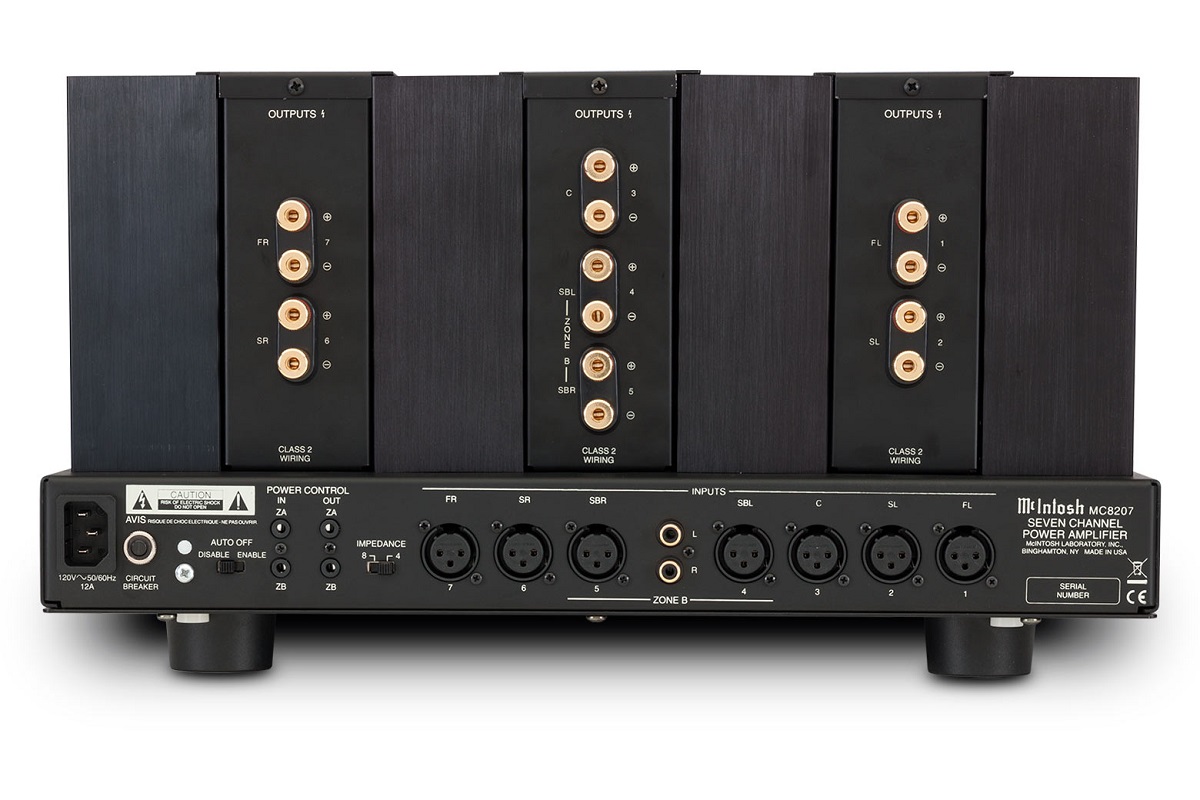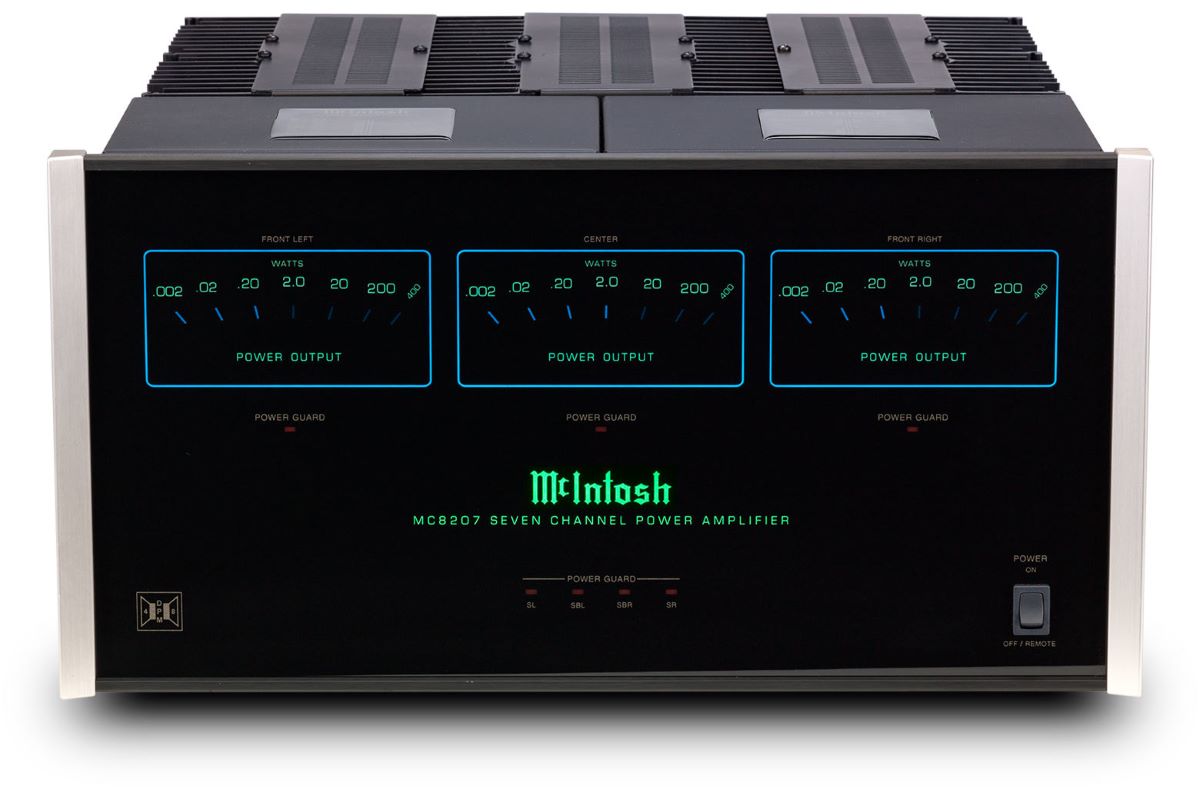McIntosh MC8207 multichannel amplifier Highlights
- Built like a tank
- Beautiful cosmetic design
- Equal power into either 8 or 4-ohm loads
- Runs relatively cool for a Class A/B multichannel amplifier
- Very black musical background
- Rich, powerful bass
- Smooth, airy treble
- Excellent midrange purity
- Good sense of dynamics
- Pinpoint imaging and sound staging
Secrets readers should need no introduction to McIntosh Laboratory Inc. McIntosh has been at the leading edge of the high-end audio market for decades now. While most commonly associated with great-sounding 2-channel equipment, McIntosh has also kept their toes dipped into the home theater/multi-channel market and has made numerous A/V pre-processors and multichannel amplifiers, such as the MC8207 amplifier we have here today. The MC8207 is a true behemoth of an amp, with a massive chassis and serious weight to go along with it.
Design:
7-channel solid-state Class A/B amplifier
Number of channels:
7
Power Rating:
200w x 7 @ 8 ohms, 200w x 7 @ 4 ohms, 20Hz-20kHz
Frequency Response:
20Hz-20kHz +0/- 0.25dB, 10Hz-100kHz +0, -3dB
Dynamic Headroom:
1.7dB
Input Impedance:
20,000 ohms Balanced; 10,000 ohms Unbalanced
Damping Factor:
>140
Voltage Gain:
29dB
Signal/Noise ratio:
>112dB below rated output
THD:
0.005%
Inputs:
7 x balanced XLR (non-locking), 2 x unbalanced RCA for second zone
Outputs:
7 pairs of 5-way binding posts
Control:
2 x 12V trigger in, 2 x 12V trigger out
Dimensions (W x H x D including binding posts):
17 ½ x 9 7/16 x 21”
Weight:
83 lbs.
Warranty:
3 years (parts and labor)
MSRP:
$7,000
Website:
Company:
SECRETS Tags:
mcintosh, power amp, multichannel, home theater, mc8207
When one purchases a McIntosh product, there is a certain expectation of build quality and elegant design, which the MC8207 more than meets. The 83-pound weight of the amp is the first indication of the overall construction quality on tap. The main chassis is heavyweight steel, with lighter bent-over steel used for the sides, back panels, and heatsinks. The front of the amplifier is a thick piece of glass with vertically brushed aluminum endcaps. A large green fiber-optic backlit “McIntosh” logo and model name are centered on the front panel, with four “Power Guard” lights below for the surround channels. These lights will glow red if there is a fault in any of the surround channels or if the amplifier overheats. A single rocker switch towards the bottom right face of the amp controls on/off functions.
The highlight of the front panel design is the “Ilumeter Power Output Indicators” for the left, center, and right channels. These show the power usage of each channel in real-time using LED lighting in green and blue in a new take on the traditional McIntosh blue analog power meters. This may be sacrilegious to some, but I actually think these look even cooler and more modern than the old-school blue analog meters on McIntosh’s more expensive components. If you use a matching McIntosh pre-amp, you can even turn the meters on and off via a 12v trigger signal from the pre-amp. Unfortunately, this only turns off the bouncing blue meter bars, not the green power indicator outlines or the large green McIntosh logo. In my darkened media room, the lighting was a bit of a distraction. I’d like to see a true “lights out” mode implemented in the future. Beneath each of the Ilumeter displays is a “Power Guard” light for the respective channel. Moving around to the back panel, the MC8207 sports a single 15-amp IEC input jack, a circuit breaker, an “auto-off” switch, two sets of 12v trigger inputs and outputs, an impedance switch (4 or 8 ohms), 7 XLR inputs, and a pair of RCA inputs for Zone 2. Oddly, the XLR connectors are of the non-locking type. The jacks aren’t that tight and as a result, it is fairly easy to dislodge the XLR cables from the MC8207 while making wiring changes.
For reliability, I’d really like to see these changed to locking XLR jacks in the future. Above the inputs are three banks of 5-way speaker binding posts. The central bank houses the binding posts for the center channel and the surround back channels. If you are only running a 5.1 setup, the two remaining surround back channels can be used to power a 2-channel system in a second zone. The binding posts themselves are nice and solid and accommodated the banana plugs of my Kimber 4VS wires with ease. Four fairly tall rubber feet keep the chassis of the amp almost two inches from the surface, ensuring adequate airflow. The overall construction quality of the MC8207 is excellent. The massive weight and steel chassis give the amp an overall feeling of solidity that is rarely experienced with today’s mass-market products.
Secrets Sponsor
At the core of the MC8207 is a large power supply offering a minimum of 1400 watts RMS of total power. This, in turn, gives a power rating of 200 watts to each of the seven channels at either 4 or 8-ohm loads through McIntosh’s Dynamic Power Manager™ technology. The DPM design enables the MC8207 “to run on higher voltage rails when connected to less current-hungry 8-ohm speakers and still deliver 200 watts.” There is also a peak output current of 25 amps per channel to ensure powerful dynamics.
On the inside, the MC8207 is identical to McIntosh’s more expensive (and now discontinued) MC207 7-channel amplifier. About 10 years ago, McIntosh decided to offer a lower-cost home theater pre-amp to complement their flagship offering. As such, they figured it would be wise to offer a similar, lower-cost alternative to the then $9,500 MC207 flagship multi-channel amp as well. However, unlike many other brands, they were unwilling to sacrifice performance in exchange for a lower price point. They decided (wisely, in my view) to simply remove some of the features and frills that made the MC207 so expensive. First, instead of the solid stainless-steel chassis, covers, and heatsinks used on the MC207, they used regular coated and rolled steel for the MC8207. Then they removed the RCA inputs from the back panel (except for the Zone B inputs). On the front panel, the expensive glowing blue analog VU meters were ditched in favor of the less expensive “Ilumeter” displays. The “Meter Off” and “Watts Hold” knobs of the MC207’s front panel were replaced with a single power switch. These cosmetic changes enabled McIntosh to offer the MC8207 for significantly less cost. While the MC207 has been discontinued for a few years now, those of you who prefer the blue analog VU meters and more robust stainless-steel chassis will want to take a look at the $11,000 MC257, the MC207’s successor.
The arrival of the MC8207 at my home was a bit of an event for me. The amp was delivered on a full-size pallet and was strapped down with metal shipping straps. The metal straps were thick enough that my metal snippers wouldn’t even cut through them. I had to pull out my Dremel tool with a cutting disc to slice through them. Then I tried to lift the rather large box. That was a mistake. The overall weight of the shipping package is about 116 pounds, way too heavy for me to safely move on my own. So, I opened the box to find a second box surrounded by thick foam packaging. This box was still too heavy to move by myself so I opened it up. Besides some additional foam, I found that the amp was bolted to a thick wooden base. I unbolted the four (4!!!!) bolts from the bottom of the wooden base plate and was finally able to lift the amp out of the box. Now down to the “mere” 83 pounds of the amp itself, I could at least carry the amp up the 19 steps to my media room on my own. McIntosh clearly takes their packaging seriously but I would highly recommend having help unboxing this monster (or get your dealer/installer to do it for you).
Secrets Sponsor
With my powerlifting for the day complete, it was finally time to get the MC8207 installed in my system. Out came my reference Wyred4Sound 7-channel Class D amp and into its place went the McIntosh. The MC8207 is exceptionally deep (particularly at the input panel) so make sure that your rack can handle it. As per the recommendations in the manual, I made sure to leave 6 inches of clearance above the amp for proper ventilation. All that was left to do was swap the seven XLR signal cables, seven-speaker cables, and 12V trigger cable from my existing setup over to the MC8207. One warning on the 12V trigger cable: using a mono cable will disable the Ilumeter power meters on the front panel. Use a stereo 12V cable if you want to see the meters “bounce.” The MC8207 was used in my 7.2 media room setup, which is controlled by a Marantz AV8801 pre/pro. Source components included an Xfinity cable box, Oppo UDP-205 UHD player, Xbox Series X, and Amazon FireStick 4K Max for streaming duties. Connected speakers were Sonus faber Olympica IIIs in the front positions, an Olympica Center for center channel duty, Olympica Is for surrounds, and Sonus faber Venere Walls for the back surrounds. My two Hsu subwoofers filled in the deep bass. Speaker cabling was Kimber 4VS for the front channels and Kimber in-wall cabling for the surrounds. Blue Jeans Cable Canare XLRs connected my pre-pro to the MC8207.
With everything properly connected, I ran a fresh Audyssey Pro calibration on my Marantz AV8801 to account for the power differences between the MC8207 and my much more powerful reference amp. Unless specifically stated, I used the Marantz’s “Pure Direct” mode to disengage all Audyssey processing and EQ during my listening sessions. This ensured that I was judging the raw sound of the MC8207 versus what Audyssey was doing to correct my room’s issues. My MC8207 review sample had been used by many previous reviewers, so it arrived fully “broken in.” However, I did find that a 15-30 minute “warm up” session was best before doing any hyper-critical listening. The amp had a slightly smoother, more fluid presentation after the brief warm-up period. This is in line with other Class A/B amps that I have used over the years. My sample also exhibited a touch of power supply buzz. McIntosh says that this is normal for a power supply as large as the one in the MC8207 (as the power supply’s electromagnetic field can vibrate components around it), but I could occasionally hear it from my seating position during silent movie/film passages. Considering that my review sample had been shipped around to numerous reviewers over the course of many years, it is highly possible that this is an issue unique to my sample.

Benjamin Zander “Mahler’s Symphony No. 5”
As I have found that multi-channel music is the true test of any multi-channel component, I started off my evaluation of the MC8207 with some well-recorded classical music. Mahler’s Symphony No. 5 with Benjamin Zander conducting the Philharmonia Orchestra (5.1-channel SACD, Telarc B00005B7KD), put the MC8207’s best qualities on full display. Starting around the 2:20 mark of “Stürmisch bewegt, mit grösster Vehemenz” there are a few instances where the strings of the violin are plucked by hand. These plucks had an absolutely perfect tone to them while remaining suitably crisp. This track uses massed strings extensively and through the McIntosh, they sounded absolutely beautiful, with the sound being very clean and accurate while still conveying the natural warmth and full-bodied tone of their wood-bodied sources. Chimes had exceptional sparkle and airiness to them without coming across as too bright.
The MC8207 also excelled at creating a sense of space, presenting each instrument (or sections of instruments) in a unique location in the soundstage. Yes, the 5.1-channel discrete nature of this recording helps this spatial positioning, but the amp still seemed to present an even more realistic sense of space than other amps I’ve had in my system. The McIntosh also did a great job capturing the raw dynamics of this track, with louder passages seeming to “jump” from my speakers. It did equally well capturing the softer sections, keeping things very clear and detailed even at lower volumes. These quiet passages were very “black” with no hiss or background noise that I could hear coming from the speakers. However, I was able to hear a bit of the hum from the MC8207’s power supply during the quietest moments.

Carmen Gomes “Up Jumped the Devil”
The MC8207 also proved excellent with jazz and female vocals, such as Carmen Gomes’ “Up Jumped the Devil” (DxD 352kHz). With my Oppo UDP-205 feeding a pure analog signal via XLR into my Marantz pre-pro, I could really hear the amazing quality of this recording. “Hellhound On My Trail” showed off a lot of the things the MC8207 does well. Gomes’ vocal is very dynamic, and the McIntosh did a great job rendering the more whispery vocals which then quickly turn into full-power notes. The percussion is really well-recorded on this track as well, with some exceptional use of cymbals. You could really hear how the drummer was striking those cymbals (Were those metal brushes? I think so). The drum beats were incredibly tight and punchy, showing off the MC8207’s great bass response. As I had noticed with the Mahler symphony, there was an overall sense of ease and fluidity in the McIntosh’s presentation that made it really easy for me to just relax and enjoy the music.

Pink Floyd “Wish you were here”
The title track off of Pink Floyd’s “Wish You Were Here” (SACD 5.1 mix) possibly showed off the MC8207’s musical abilities best. The clarity and tone of the steel-stringed acoustic guitar starting at the 1:00 minute mark was absolutely spot-on, making it almost sound like the guitar was in my room. David Gilmour’s vocals sounded great, sitting nicely in the center channel while being filled in by the left and right front speakers. This gave the vocal a bit of extra depth and presence that I really liked. The surrounds are used very actively in this mix and blended in perfectly with the main front three channels. The sound field was completely cohesive and enveloping, which is key for delivering this track as it was intended. I played this track back quite loud (easily over 95dB) and was humbled by the fact that the power meters on the MC8207 were only lighting up a bit over the 20-watt mark. Trying to peg the meters at the 200-watt line proved futile, with the overall volume getting far too loud for my ears. To the MC8207’s credit, I didn’t detect any harshness or distortion creeping into the sound, even with these absolutely excessive levels. Unless you have sub 85-dB efficient speakers, listen in a massive room, or just love 110dB+ levels of output, the 200 watts of power offered by the MC8207 should prove more than adequate. Even after cranking this song, I found that the McIntosh’s top panel was only moderately warm.



McIntosh and “value” don’t typically go hand in hand. However, the MC8207’s combination of gorgeous design, impressive build quality, and excellent overall performance make the $7,000 price a little easier to justify, i.e., “excellent value for the dollar”. Oh, and did I mention it has cool blue and green power meters?
- Huge power on tap.
- Outstanding build quality.
- Exceptional Sound quality.
- Cannot dim or completely turn off the front panel lights or power meters.
- The chassis is very deep.
- Power supply generates an audible hum.
- Locking XLR input jacks would be nice.
In my experience, McIntosh components have a signature house sound consisting of a rich midrange, clean, sweet treble, and potent bass output. The MC8207 fits this description to a “T.” This voicing really flatters well-recorded music and makes it easy to “bond” with the overall sound. It also helps make poorly recorded music far more enjoyable. There is an effortless nature to the sound which encourages you to just sit back, relax, and enjoy your music or movie. As an added bonus, the MC8207 truly complemented my Sonus faber Olympica speakers and created an overall beautiful (but not overly lush) sound that I personally loved. Minor quips about the slight power supply buzz and inability to completely dim the front panel aside, the McIntosh MC8207 is an excellent-sounding amplifier for a top-tier multichannel system. While fantastic with movie soundtracks, I feel it is even better with more demanding music sources, be they 2-channel or multichannel. This is a multichannel amp that even a hardcore 2-channel audiophile would be hard-pressed to find fault with. If you are looking to build a top-flight multichannel system, the McIntosh MC8207 is certainly worth a closer look.





